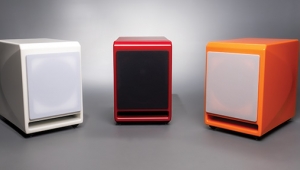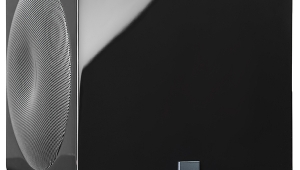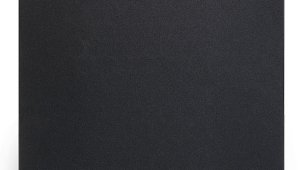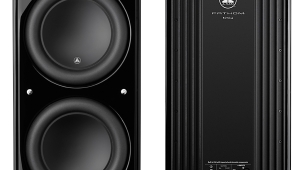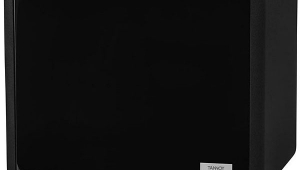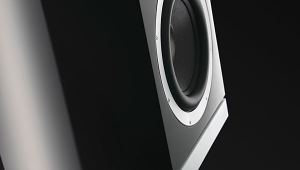| Columns Retired Columns & Blogs |
Gradient SW-57 subwoofer
There are two kinds of audiophiles: those who own original Quad ESL speakers and those who don't (footnote 1). This review is for the former, although the latter may find it of some interest. The Gradient SW-57 subwoofer attempts to do for the original Quad (footnote 2) what Gradient's SW-63 (footnote 3) does for the Quad ESL-63: supply the bottom octave while relieving the ESLs of the strain of reproducing low bass.
Footnote 1: There is a third group: those, like me, who once owned original Quad ESLs, and every other day wish they'd never gotten rid of them.—John Atkinson
 The Gradient SW-57 subwoofer utilizes two 8" woofers in a free-air enclosure. This technique attempts to mimic the dipole radiation pattern of the original Quad ESL. The SW-57 subwoofers also contain a circuit to protect the ESL tweeters from excessive voltage. This circuit can be bypassed, however, if the owner has had new protection circuits installed in the speakers or just enjoys living dangerously.
The Gradient SW-57 subwoofer utilizes two 8" woofers in a free-air enclosure. This technique attempts to mimic the dipole radiation pattern of the original Quad ESL. The SW-57 subwoofers also contain a circuit to protect the ESL tweeters from excessive voltage. This circuit can be bypassed, however, if the owner has had new protection circuits installed in the speakers or just enjoys living dangerously.
The Gradient SW-57 comes with an active crossover powered by a small external AC transformer. The box has a subwoofer level control, a subwoofer-mode toggle switch for stereo or mono, and a midrange adjustment switch with bypass and two built-in equalization curves. This last switch is designed for ESLs that may have lost some of their high-frequency extension to age and wear. Original Quads often develop holes in their protective outer plastic bags that permit dust to settle on the drivers. This dust build-up attenuates the efficiency of the Quads' high-frequency drivers and results in lower spls. The midrange adjustment can sometimes restore Quad ESLs to their original harmonic balance (footnote 4).
Set-up
The Quad/Gradient system was set up in my smaller listening room (see my Atma-Sphere MP-1 review in Vol.16 No.12, p.165). The speaker system was approximately 42" from the back wall and 36" from the side walls. The speakers were toed-in so that the ESL panels pointed directly at the center listening position. A Proton VT-331 TV monitor was between the speakers.
Sound
First, the good news. With the SW-57 subwoofers, the Quad ESLs play louder and with far less strain than when operated full-range. The subwoofers also remove the midbass hump around 80Hz that is very much a part of the original Quad ESL sound. In terms of harmonic balance and dynamic energy, the SW-57 integrates seamlessly with the Quad's midrange/woofer panels—due to the two units' very similar radiation patterns and the SW-57's placement beneath the panels.
The SW-57's small footprint and its rigid screw mounting to the base of the ESLs make the Gradients convenient and unobtrusive, unlike a majority of other ESL subwoofer schemes I've seen. The addition of modern protection circuitry is a boon for foolish Quad owners who ignore the speaker's 50W maximum power handling and insist on using overpowered solid-state amplifiers to drive the ESL panels. The three-point spike system on the SW-57's base allows the integrated system to be tilted back at specific angles—important for optimizing vertical imaging characteristics.
The original Quad ESLs were among the first speakers made that could be said to "image"; ie, to actually re-create a semblance of a recording's dimensional and spatial characteristics. The Gradient SW-57 manages to stay out of the ESL's way in this respect. How nice. The original Quads, however, are still "one-person speakers" whose listening window is just large enough for one human head, as long as it isn't too fat or prone to sway, bob, or weave (rope-a-dope practitioners are out of luck).
While the Gradient SW-57 integrated very well visually and aurally with the original Quads, from my listening position I found that the Quads were at least 4" too short to image optimally. If you don't raise the speakers, you may get the "classic" Quad soundstage: looking down from the first balcony. Anyone who has tried to use the original Quads with their pitiful little standard legs (which make excellent kindling) will be familiar with this effect. I put bricks under each of the Gradients' spikes, which brought the system to the correct height for listening from my futon couch. If you use a chair of normal height, you may have to raise the system 6–7" (footnote 5).
Now the bad news. Although the Gradient SW-57 is called a subwoofer, my definition of the term—ie, a speaker that covers the 20–40Hz range—says that it is not. Although it does get down to 40Hz, anything lower is attenuated nearly to the point of inaudibility. Organ-music enthusiasts will be disappointed by the lack of bottom-octave power and extension. Aficionados of large-scale orchestral works will also be disappointed by the still-limited dynamic extension of the original Quad/Gradient SW-57 system. With some pieces—like Klaus Tennstedt's live recording of Mahler's Symphony 1 with the Chicago Symphony (EMI CDC 7 54217 2)—I found that the system ran out of steam, severely compressing anything louder than mezzoforte.
My final and related complaint about the Gradient SW-57 subwoofers is their propensity to distort when fed substantial bass power. I ran some tests with the subwoofers alone and found that 15, 20, 25, and 30Hz test tones at any volume over 90dB at my listening position (7' away) resulted in noticeable distortion in the forms of driver noise, harmonics, and cabinet buzz. Reggae-lovers beware: It's easy to roast these suckers if the volume on your old Wailers records gets too insistent.
Bottom line
"Too little too late" comes to mind when I think about the original Quad/Gradient SW-57 system. The SW-57's window of opportunity has shrunk to a mouse-hole over the passing years (footnote 6).
If you're the sort who must have your listening room neat, neat, neat, or your spouse has (through the goodness of her or his heart) allowed you to live with original Quads but has blanched at the idea of a large box taking up valuable space, the Gradient SW-57 subwoofer system may seem the answer to your prayers. For some original Quad owners, however, it'll be an expensive step back from their own home-brew solutions to the Quad's lower-octave problem. However, if you can live with only limited additional bass and dynamic extension, the Gradient SW-57 may be just the thing. But if you're looking for a quantum leap in performance—which, at $2000, I believe you should expect—you may be disappointed. Caveat emptor.
Footnote 1: There is a third group: those, like me, who once owned original Quad ESLs, and every other day wish they'd never gotten rid of them.—John Atkinson
Footnote 2: Dick Olsher reported on modifying the Quad ESL in August 1987, Vol.10 No.5, p.164. Art Dudley reported on restoring a pair of original Quads in June 2006 and July 2006.—John Atkinson
Footnote 3: Larry Greenhill's reports on his experience with the SW-63 appeared in Vol.14 No.10, p.184 and Vol.16 No.3, p.134.—John Atkinson
Footnote 4: A better way to restore that original harmonic balance is to send your old Quads to QS&D Service, 33 McWhirt Loop #108, Fredricksburg, VA 22406, Tel: (703) 372-3711. They can be disassembled, cleaned, and fully restored by folks who've been working on Quads for over 20 years. QS&D can also loan you shipping boxes for the trip to and from Virginia. The pair of boxes they sent me survived several trips via UPS quite nicely. I had QS&D restore my Quads as part of the Gradient SW-57 review process. After ten years of hard service, my Quads were in serious need of restoration. Not only did QS&D fully disassemble and clean them, but both tweeter panels were replaced, new protection circuitry was installed, and the original banana-plug connections were replaced with five-way binding posts.—Steven Stone
Footnote 5: Original Quad owners who want to raise the speakers without placing them on subwoofers should investigate Arcici's excellent $265/pair stand. Arcici, P.O. Box 704, Islip Terrace, NY 11752. Tel: (516) 581-7006.—John Atkinson
Footnote 6: Over the original Quad's 25 years of production, more than 60,000 were manufactured. The speaker regularly appears on the secondhand market; I suspect that SS is being too pessimistic in his prognostications.—John Atkinson
- Log in or register to post comments
